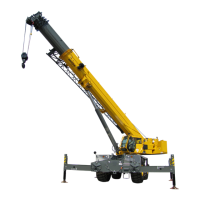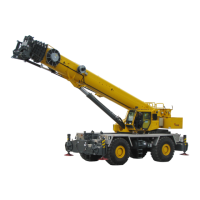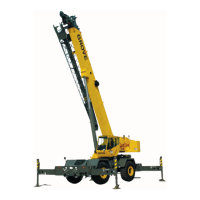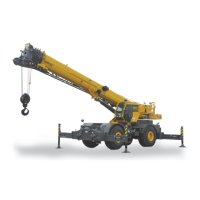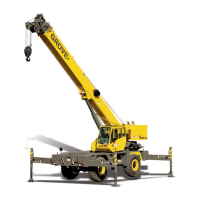Grove Published 11-22-2016, Control # 345-12 2-7
RT9130E-2 SERVICE MANUAL HYDRAULIC SYSTEM
A component functioning at reduced efficiency may indicate
that the control valve for that component is leaking internally.
If preliminary checks reveal that adequate volume is being
supplied to the affected valve bank, relief valves are properly
adjusted, and the component is not at fault, check the valve
for scored or worn parts. Scoring is a sign of the number one
problem in hydraulics - contamination (external
contamination by dust or internal contamination by debris
from deteriorating components or oxidized hydraulic oil).
Scored or severely worn valve components must be
replaced.
Check valves in the control valves are designed to permit a
flow of hydraulic oil in one direction only. If a piece of dirt or
rust has worked its way into the check valve and lodges
between the poppet and seat, it will keep the valve open and
allow a return flow of hydraulic oil. The remedy is to clean the
valve, but it is also a good idea to follow through and ensure
the hydraulic system filter is still serviceable.
Binding Spools
Some of the most common causes for stiff spool movement
or jammed spool action are system overheating, excessive
pressure, contaminated or deteriorated hydraulic oil, or
warped mountings. When scorched, deteriorated hydraulic
oil or contamination is the cause, flushing the system and
replenishing with clean hydraulic oil may solve the problem.
If the spool bores are badly scored or galled, the valve must
be removed for servicing.
Warping occurs when mounting plates are not level or they
become distorted from machine damage. As mentioned
previously, the valve can be shimmed level.
Also, check the valve for rust. Rust or dirt collecting on the
valves can prevent free movement of the spool, and keep it
from the true center position. Excessive system pressure
can create both internal and external leaks in valves that are
otherwise sound. Only qualified technicians using the correct
equipment should make pressure adjustments when
pressure adjustments are needed.
Visual Inspection of Hoses and Fittings
1. Visually inspect hoses and fittings once a month or
every 250 hours for the following:
• Leaks at hose fitting or in hose
• Damaged, cut, or abraded cover
• Exposed reinforcement
• Kinked, crushed, flattened, or twisted hose
• Hard, stiff, heat cracked, or charred hose
• Blistered, soft, degraded, or loose cover
• Cracked, damaged, or badly corroded fittings
• Fitting slippage on hose
• Other signs of significant deterioration
If any of the above conditions exist, evaluate hose
assemblies for correction or replacement. For replacement
of hose assemblies, refer to your Manitowoc Crane Care
Parts Manual.
2. At the same service interval, visually inspect all other
hydraulic components and valves for the following:
• Leaking Ports
• Leaking valve sections or manifolds and valves installed
into cylinders or onto motors.
• Damaged or missing hose clamps, guard, or shields.
• Excessive dirt and debris around the hose assemblies.
If any of these conditions exist, address them appropriately.
3. Hydraulic hose assemblies operating in a temperature
climate zone “C” (Table 2-1) are recommended to be
replaced after 8000 hours of service life.
4. Hydraulic hose assemblies operating in climate zones
“A” and “B” (Table 2-1) with high ambient temperatures,
could see hose service life reduced by 40 to 50%,
therefore, it is recommended to replace these hoses
after 4000 to 5000 hours of service life.
5. Hydraulic hose assemblies operating in climate zones
“D” and “E” (Table 2-1) cold climates should expect a
degradation of mechanical properties such as elasticity,
therefore, it is recommended these hoses be inspected
and addressed accordingly.
Table 2-1
CAUTION
Ensure that the hydraulic hose is depressurized before
loosening the connections.
Zone Classification
A Tropical Moist: All months average above 64° F (18° C). Latitude 15° - 25° North and South
B Dry or Arid: Deficient precipitation most of the year. Latitude: 20° - 35° North and South
C Moist Mid-Latitude: Temperature with mild winters. Latitude: 30° - 50° North & South
D Moist Mid-Latitude: Cold winters. Latitude 50° - 70° North & South
E Polar: Extremely cold winters and summers. Latitude: 60° - 75° North & South
